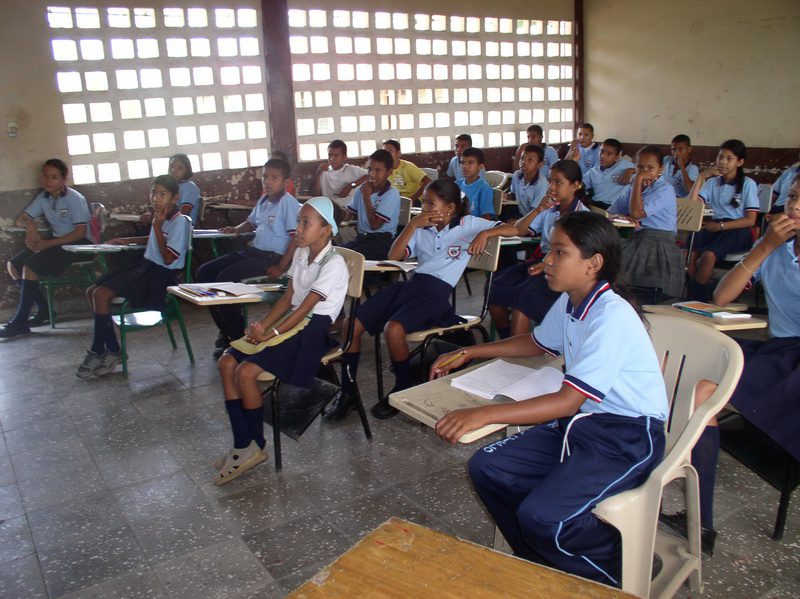Colombia’s diverse landscapes and rich history offer endless adventures, while the growing demand for English proficiency provides amazing job propspects for those looking to teach ESL. Whether you’re an experienced teacher or just starting, this vibrant country presents a world of opportunities for personal and professional growth for those who choose to teach English in Colombia.

Colorful streets in the Port city of Cartagena
Why teach English in Colombia?
Just a handful of reasons to consider teaching English as a second language (ESL) include the low cost of living, the prevalence of jobs, and the stunning mountains and picturesque beaches.
Additionally, you can consider a few factors that might make Colombia even more attractive to foreign English teachers than other destinations:
- Close proximity to North America. The most popular locales for English as a second language (ESL) work – like South Korea, China, the UAE, to name a few – are quite far from home if you’re American. Some are literally on the other side of the world. Colombia’s a skip and a hop across the Caribbean and shares the same time zone as Chicago.
- Moderate, warm weather. Not only does Colombia never get excessively cold; it also never gets overly hot. Most of the year, the temperature remains comfortably between 65-90 degrees Fahrenheit.
- It’s among the safer Latin American countries. Government crackdowns on crimes in recent years in service to the tourism industry have made Colombia significantly safer for foreign travelers and expats. 4.6 million tourists graced Colombia’s shores in 2022 – the vast majority of whom experienced no crime.

One of the many landscapes in Colombia – Cocora Valley at Salento, Colombia
What are the requirements to teach English in Colombia?
Colombia is notably more lenient in its standard teacher requirements than other destinations with stricter requirements.
Here’s what you’ll need, as a general rule with notable exceptions, to teach English in Colombia:
- A 120-hour, fully accredited TEFL certificate. TEFL Hero’s comprehensive 120-hour course is only $99, is fully self-paced, and is backed up by leading agency ACCREDIT – which means it’s universally recognized. It also has a 9.4/10-star rating on Go Abroad.
- Sufficient savings to get set up in Colombia (around $1,000 should be more than enough as the cost of living is substantially lower in Colombia). If you land a job before you arrive, you could potentially get by on less until your first paycheck.
- Advanced English proficiency (if you’re not a native speaker, a high CELTA score or results from a similar test can demonstrate your skills to employers)
- A university degree (sometimes but certainly not all the time). Even if the employer does not explicitly require it – a degree can make you more of an attractive candidate and offer more job opportunities.
Can you teach English in Colombia without a degree?
Yes! You do not need a degree nor must you be a native speaker necessarily to get a job – although both are assets. You won’t be as competitive as a candidate if you lack one or the other, but it’s definitely still possible to land a decent job and should not be a reason to discount teaching in Colombia.
TEFL in Colombia: salary and cost of living
The salary for an ESL teacher in Colombia is markedly lower than you would expect to earn in China, South Korea, or other popular Asian countries. That said, the cost of living is exponentially cheaper, so this should be taken into consideration when looking at the local salaries.
How much do teachers make in Colombia?
The pay for ESL work is generally not commensurate with what one might expect from a comparable position in, say, the UAE, South Korea, Japan, etc. – more advanced economies with more to spend on teachers.
In general, you can expect to make $500-$1,000/month, depending on the institution and your qualifications (see “types of English teaching jobs in Colombia” section for a breakdown by school type).
What’s the cost of living in Colombia?
Here’s a breakdown of daily living expenses in Colombia’s capital city, Bogota, per Numbeo:
- $3.73 for a meal at an affordable restaurant
- $1.25 for a loaf of bread
- $2.11 for a dozen eggs
- $1.02 for a bottle of domestic beer
- $383 for a month’s rent in the city center, $301 for an apartment outside of the city
Keep in mind that these costs reflect the prices in a large city such as Medellin or Bogota; they are likely substantially lower on average in areas outside of major urban centers.

Colombian cuisine is both affordable and filling. Look out for menu del dia lunch specials for the working crowd
Can I save while teaching ESL in Colombia?

Colombian Pesos
As you can see in the above analysis, the price of everyday goods and services in Colombia is significantly lower than what you would pay in an American or Canadian municipality.
So, while $500-$1,000 doesn’t seem like very much at all, it’s still possible to save money if you’re frugal.
Here are some tips for making the most of your ESL salary:
- Take public transportation whenever possible rather than taxis for short trips or airplanes for long trips. There are often buses that will bring you between Colombian destinations at a fraction of the cost of flying.
- Negotiate perks from your employer. In many cases, employers will subsidize your cost of living such as supplying an apartment or, potentially, airfare reimbursement (usually reserved for higher-end positions).
- Take up part-time tutoring work to supplement your income. You may find clients from the same school you teach at for your day job who want some more intensive, one-on-one instruction. Teaching English online is also another income stream that will pay in USD – another benefit of living in a LCOL country.
Types of English teaching jobs in Colombia
Let’s look at some of the main types of English teaching jobs available to ESL teachers in Colombia and their respective average salaries, requirements, etc.
Private International Schools

Source: CGB
Salary range: $1,200-$2,500/month
So-called “international schools” – a specific designation that means a majority of the student body and staff is not from the host country – offer by far the highest pay rate for ESL teachers.
That said, these positions are also highly competitive.
High-profile international schools in Colombia include Colegio Gran Bretana in Bogota and Colombo Americano in Medellin.
Requirements:
- Four-year university degree (in some cases, a master’s level or above may be required)
- CELTA accreditation or similar (for non-native speakers)
- TEFL certification from an accredited provider
- Prior teaching experience (preferred)
TEC Program

Source: International Volunteer HQ
Stipend: $500/month
The Teach English in Colombia Program (TEC) is a nationwide English training program free to all Colombians. It’s exclusively available to United States citizens. While technically a volunteer program, participants do earn a stipend of roughly $500/month. Sometimes help with rent might also be available.
Requirements:
- US citizenship
- Bachelor’s degree
- TEFL certificate (sometimes required)
Public/Government School

Source: Colombia Info
Salary range: $500-$1,000/month
Contracts for ESL teachers in government schools throughout Colombia are prevalent, including in rural areas where private schools are not likely to exist. However, these institutions generally pay less than private language schools and substantially less than international schools.
Requirements:
- Bachelor’s degree
- TEFL certificate
Private Language Institutes

Teaching adults or kids on weeknights and weekends is a great way to make a living in Colombia
Salary range: $900-$1,800/month
Families with the resources and working professionals eager to develop their lingual skill set will often shell out significant sums of money to private language institutes across the country that provide after-school or after-work English instruction.
Hours of work at training centers tend to be when everyone else is not working – think weeknights and weekends. These hours may be great for some teachers, but not for all.
Requirements:
- Bachelor’s degree
- TEFL certificate (in most cases)
Where to teach English in Colombia
Let’s have a look-see at the three top ESL destinations in Colombia (which also happen to be the three largest cities). The vast majority of private-sector ESL jobs are concentrated in these municipalities.
Medellin

Thanks to pop culture, you might be most familiar with Medellin as the birthplace of one Pablo Escobar – but he’s long gone and it’s so much more than that.
Today, Medellin is a thriving, mostly safe metropolis as Colombia’s second-largest municipality, home to over four million people.
Bogota

Bogota is the capital and largest city in Colombia, as well as the seat of the federal government. A plurality of the country’s elites are located in Bogota, and, as a result, ESL jobs tend to be higher-paying here.
Cali

If you’re into the beach life (and who isn’t?), you might consider Colombia’s third-largest city by population, Cali, which straddles the Pacific coast.
How to find jobs teaching English in Colombia
Ready to hit the ground running? Let’s briefly explore when and where to start on your ESL quest in Colombia.
When to start
As the Colombian school year starts in January (with some exceptions) the ideal job search period begins by November.
However, private language institutes tend to hire year-round.
Where to start
Placement Programs
Placement programs are often the best bets for new teachers unfamiliar with the industry. The benefits of these over the DIY placement route are that they typically take care of all the logistical issues like visas, acclimating to a foreign culture, locating schools, etc. Check out Go Overseas for a smattering of placement programs in Colombia.
Online job boards
Utilizing online job boards such as Teach Away, Dave’s ESL Café, and Glassdoor is the preferred method of locating jobs for many seasoned teachers.
Like any option here, job boards have benefits and drawbacks. On the plus side, they endow you with more freedom to negotiate your own salary, refine your search by geography and school type, and coordinate your own living arrangements.
The major disadvantages of the DIY job board method are that these positions often lack the institutional support (for visas, living arrangements, etc.) that you’d expect with most placement programs and, unfortunately, the occasional scam.
<image: glassdoor job ad>
In-Country
Pound-the-pavement. If you have an adventurous streak and want to get super old-fashioned – ideal for snagging jobs in schools located in lesser-traveled, remote areas with no digital footprint – you can always hop on a plane and do the physical door-knocking routine. Just be sure you have some backup currency to sustain you.
Many schools in Colombia and elsewhere are partial to teachers already in-country, so even if you’re looking for jobs online, it can’t hurt to already be physically present in Colombia, assuming you have the resources to make it work until you find employment.
What visa you’ll need
When you arrive in Colombia – with an American, UK, Australian, French, or German passport – you get an automatic 90-day stamp upon arrival. Canadians receive the same, but with a small fee attached. And you can easily get another 90 days once you’re in-country via this form.
But to legally work in Colombia as an ESL teacher or in any capacity, you’ll need to obtain an M5 work visa. Here is the digital application form.
Your employer or the program you are using should guide you through the process. Make sure you discuss the visa application process prior to signing any contracts.
How to get hired
Here are a few tips to make your candidacy as attractive as possible to employers:
- Get TEFL-certified (the ideal course is at least 120 hours and accredited). Be sure to add your TEFL certificate in your education section of your CV and highlight any teaching or teaching-related experience to your resume!
- Assemble all relevant documents, the most important of which include: passport-sized, professional photos, your passport itself, your resume, and scanned or digital copies of your university diploma, TEFL certificate, and any other relevant documents.
- Hit the job boards. Start with eslcafe.com, in my opinion.
- Send follow-up emails after any interviews and if you don’t hear back from a school you’re really interested in within a week of the initial email/application. Diligence pays off.
FAQs About Teaching English in Colombia
Let’s dive into a set of frequently asked questions (FAQs) vis a vis ESL work in Colombia.
Is it safe to teach in Colombia?
Colombia has become increasingly safer in recent decades. Certain municipalities and regions, like Bogota, are safer than others.
Do I need to know Spanish to teach in Colombia?
No, Spanish proficiency is a plus but not required.
Can I save money teaching in Colombia?
It’s possible to save a couple of hundred dollars per month in some cases, although not all.
Are English teachers in demand in Colombia?
Yes, English teachers are in high demand worldwide, including in Colombia.
Where does this post come from?
This post was originally published at How to Teach English in Colombia: Beginner’s Guide 2023 on the TEFL Hero Website.


